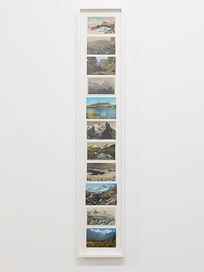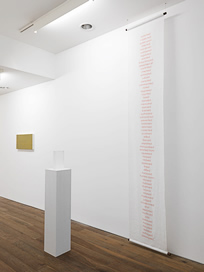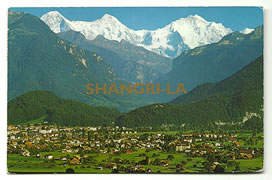Main Gallery
Simon Morley
Lost Horizon
7 February - 22 March, 2014
For Simon Morley’s fourth exhibition at Art First, he tackles the conundrum of Utopia. The show self-avowedly refers to his new home in Seoul, and the near-visible ‘utopian’ construct of North Korea. He writes: “… a few dozen miles north lies a monstrous nation… its leaders persist in the most absurdly ruinous and barbaric attempt to realize Shangri-La…”
Morley takes Frank Capra’s 1937 film Lost Horizons as a lodestone. In his introductory essay for the exhibition catalogue, the writer Ryan Bishop tells us: “In Morley’s stunningly varied monochromatic vision, the Lost Horizon proves lost and found at every turn, every fold, every surface. The paintings, scrolls, screen, video, postcards with text, word lists, watercolours and book paintings offer negative spaces for critically thinking what it means… to lose a horizon for good and ill. America and Asia as visually constructed imaginaries vanish down the perspectival hole Morley erases, re-invokes and re-visions”.
By way of introduction to the show, a work in ink on Chinese linen, called To be Governed... (Proudhon), lists extreme expressions of dissatisfaction with society, sourced from the writings of the 19th Pierre-Joseph Proudhon. Morley quotes from the full text:
To be governed is to be at every operation, at every transaction noted, registered, counted, taxed, stamped, measured, numbered, assessed, licensed, authorised, admonished, prevented, forbidden, reformed, corrected, punished…
The text continues with more descriptions of what takes place in the name of the status quo; a list which makes as pertinent reading today as it did then.
Citing Thomas More’s much loved quotation, “Nobody owns anything but everyone is rich – for what greater wealth can there be than cheerfulness, peace of mind, and freedom from anxiety?” Morley summarises the reach of this exhibition:
The dream of a perfect society certainly didn’t originate with Thomas More’s famous work of 1516. He just gave it another name: Utopia. It’s a dream that is probably as old a mankind itself and it has gone by many names. In one of my works for this exhibition I’ve listed 39, but there are certainly more. They can be found in many different cultures, contexts and periods – expressed in forms as diverse as ancient myths, religions, political ideologies, fiction, Hollywood movies, and the virtual realities of cyberspace.
The subject is appropriate for the editor of the Whitechapel Gallery’s recent publication The Sublime. As an artist and writer, Morley constantly explores and examines society and its mores. The book paintings and text works (collages, sculptures etc.), for which he is best known, constitute meditative reflections on the signifiers on which we rely.
Simon Morley lives and works in England, France and South Korea. His best-known academic publication is Thames & Hudson’s Writing on the Wall (2003). In 2010 he edited The Sublime, co-published by MIT Press and the Whitechapel Gallery. He is a Professor of Fine Art at Dankook University in South Korea, and holds the post of Visiting Fellow at Winchester School of Art.








